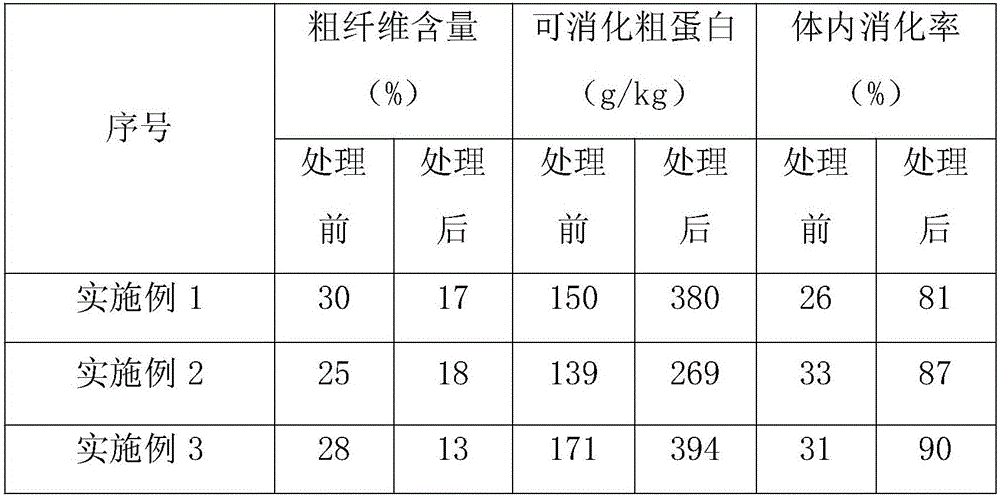Treatment method of rice and wheat straw
A treatment method, rice and wheat straw technology, applied in the direction of soil preparation methods, organic fertilizers, animal feed, etc., can solve problems affecting crop planting, slow rotting, bronchitis and cancer, and achieve improved application value, long shelf life, and nutrition The effect of improving ingredients and content
- Summary
- Abstract
- Description
- Claims
- Application Information
AI Technical Summary
Problems solved by technology
Method used
Image
Examples
Embodiment 1
[0026] A method for processing rice straw, comprising the steps of:
[0027] 1. In the field, the straw is cut into the root stubble part and the upper stem part in the ground;
[0028] 2. The upper stem is treated to make feed:
[0029] (1) Putting the upper stem part of the fresh rice straw into the extrusion equipment, pouring the extruded juice into the paddy field, and drying the extruded straw;
[0030] (2) The straw is crushed into 3 cm straw particles, after being treated by alkalization and salt water immersion, the straw particles are dehydrated by a centrifugal dehydrator, and feed particles are made by a granulator;
[0031] Wherein, the specific step of alkalization treatment is to soak the pulverized straw particles in an aqueous alkali solution for 8 hours at a temperature of 20°C, the mass percentage concentration of the aqueous alkali solution is 3%, and the alkali in the aqueous alkali solution is hydrogen hydroxide sodium.
[0032] The salt water soaking ...
Embodiment 2
[0039] A method for processing rice straw, comprising the steps of:
[0040] 1. In the field, the straw is cut into the root stubble part and the upper stem part in the ground;
[0041] 2. The upper stem is treated to make feed:
[0042] (1) Putting the upper stem part of the fresh rice straw into the extrusion equipment, pouring the extruded juice into the paddy field, and drying the extruded straw;
[0043] (2) Crushing the stalks into 5 cm stalk granules, after being treated by alkalization treatment and soaking in salt water, the stalk granules are dehydrated by a centrifugal dehydrator, and feed granules are made by a granulator;
[0044] Wherein, the specific step of alkalization treatment is to soak the pulverized straw particles in an aqueous alkali solution for 10 hours at a temperature of 25° C., the mass percentage concentration of the aqueous alkali solution is 6%, and the alkali in the aqueous alkali solution is hydrogen hydroxide potassium.
[0045] The salt w...
Embodiment 3
[0052] A method for processing rice straw, comprising the steps of:
[0053] 1. In the field, the straw is cut into the root stubble part and the upper stem part in the ground;
[0054] 2. The upper stem is treated to make feed:
[0055] (1) Putting the upper stem part of the fresh rice straw into the extrusion equipment, pouring the extruded juice into the paddy field, and drying the extruded straw;
[0056] (2) Crushing the stalks into 1cm stalk granules, after being treated by alkalization treatment and soaking in salt water, the stalk granules are dehydrated by a centrifugal dehydrator, and feed granules are made by a granulator;
[0057] Wherein, the specific step of alkalization treatment is to soak the pulverized straw particles in an aqueous alkali solution for 5 hours at a temperature of 10° C., the mass percentage concentration of the aqueous alkali solution is 2%, and the alkali in the aqueous alkali solution is hydrogen hydroxide sodium.
[0058]The salt water s...
PUM
 Login to View More
Login to View More Abstract
Description
Claims
Application Information
 Login to View More
Login to View More - R&D Engineer
- R&D Manager
- IP Professional
- Industry Leading Data Capabilities
- Powerful AI technology
- Patent DNA Extraction
Browse by: Latest US Patents, China's latest patents, Technical Efficacy Thesaurus, Application Domain, Technology Topic, Popular Technical Reports.
© 2024 PatSnap. All rights reserved.Legal|Privacy policy|Modern Slavery Act Transparency Statement|Sitemap|About US| Contact US: help@patsnap.com








